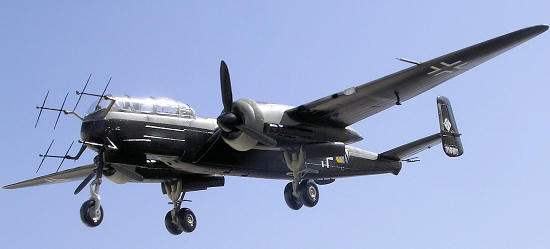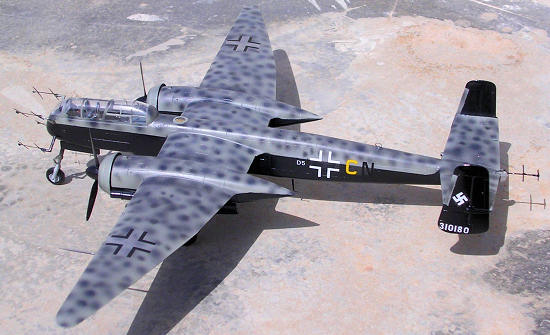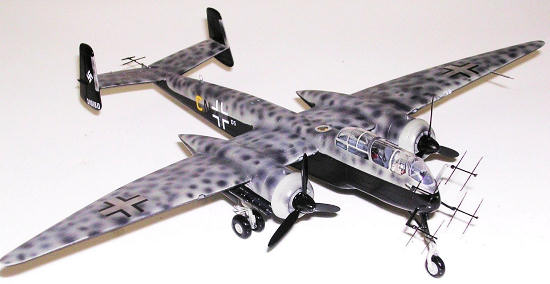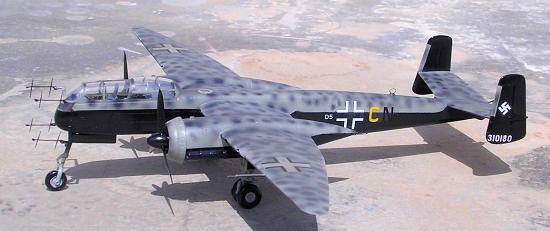Dragon 1/72 He-219B-1
|
KIT #: |
50279 |
|
PRICE: |
£18.50 |
|
DECALS: |
Three options |
|
REVIEWER: |
Carmel J. Attard |
|
NOTES: |
Includes photo etch fret |

Potentially one of Luftwaffe’s most
effective fighters the He-219 Uhu (Owl) was another aircraft, which suffered
from misjudgment by senior members of the government and Luftwaffe high command.
It derived from Heinkel’s private venture P.1060 fighter-bomber proposals, which
received little encouragement until 1941 when it was soon to have promised as a
night fighter. An all-metal shoulder-wing monoplane the He-219 seated the pilot
and navigator back to back was the first operational aircraft in the world to
introduce ejection seats and also Luftwaffe’s first operational aircraft with
tricycle landing gear.
 The
first prototype recorded its maiden flight on the 15th
November 1942 with a power plant based on two 1,750hp Daimler-Benz DB603A
engines. The second prototype flown in December had a different armament
installation. Following the evaluation of one of the prototypes a mock combat
against a Do-217N and a Ju-88S, an off the drawing board order for 100 aircraft
was increased to 300, and further prototypes were used in the aircraft
development programme. From April 1943 a small number of He-219A-O
pre-production aircraft flew with 1/NJG1 at Vento in the
Netherlands
and on the night of
11th
June 1943
Major Werner Streib shot down five Avro Lancaster bombers in a single sortie.
The
first prototype recorded its maiden flight on the 15th
November 1942 with a power plant based on two 1,750hp Daimler-Benz DB603A
engines. The second prototype flown in December had a different armament
installation. Following the evaluation of one of the prototypes a mock combat
against a Do-217N and a Ju-88S, an off the drawing board order for 100 aircraft
was increased to 300, and further prototypes were used in the aircraft
development programme. From April 1943 a small number of He-219A-O
pre-production aircraft flew with 1/NJG1 at Vento in the
Netherlands
and on the night of
11th
June 1943
Major Werner Streib shot down five Avro Lancaster bombers in a single sortie.
He
first six operational sorties flown by the unit resulted in claims for 20 RAF
aircraft including six examples of the redoubtable De Havilland Mosquitoes.
Despite cancellation of the programme in May 1944, production deliveries of a
number of versions were made, principally to 1/NJG1 and NJGr10.One particular
change was made to the wingspan, which, in the 219B variant, was extended and
tapered at the tips to give it better performance when operating at high
altitude.
Impressive
scores aside, the He-219 suffered from excessive weight growth during its
development, a process that gave its tricky and often unforgiving handling
trials. Only few production aircraft made it into service and was therefore
ineffective in the course of the war.
The
kit comes in a sturdy cardboard box with a vivid night scenery box art of a
He-219 knocking down a
Lancaster
bomber (one of five recorded downed by the He-219 during its short service
life.) Inside are five sprues of injection moulded parts in grey plastic; two
sprues of clear parts and a photo etch set. All the sprues are contained in
sealed bags and the latter two also contained in separate bags and are taped to
a cardboard sheet to protect them. The decal shee t
caters for three aircraft. The kit is made up of 113 parts. There are also a
dozen extra items that can be of use.
t
caters for three aircraft. The kit is made up of 113 parts. There are also a
dozen extra items that can be of use.
Dragon supplies the instructions in folded A5 size pages and there are eight
stages of construction. There is no brief history coverage and there are
optional parts for the nose wheel and for the rear cockpit radar layout.
The assembly is well highlighted as one goes along and
interior colour details are given at each stage.
The kit has beautifully moulded parts, no flash
at all and perhaps the only cleaning required is at the joining portion of the
part with the sprue otherwise cleaning is merely at the seam lines of the
undercarriage legs which is absolutely minimal. There are plastic ejector marks
on the undercarriage doors that needs to be smoothened down, others are mainly
in hidden places. The kit has detailed interior with the seat bases moulded onto
the floor and only needs the separate seat back to be added. The front has the
main instrument panel in photo etch item. There is also an aiming sight as well
as a front interior armour transparent screen. The engineering on the exterior
parts are in form of access panel lines neatly done. If on the other hand this
might look slightly overdone this will be quite faint after paintwork.
 The main
gear is two separate sub assemblies containing many detail parts whereas the
nose wheel has no interior detail at all. This may possibly be due to the small
size of the bay itself where any detail added may not be appreciated. The photo
etch contain several antennae. There is also a loop antenna among them. This
will go over the rear fuselage and two other antennae fit under the fuselage
which when in place look very realistic and to scale. One of these has to fit in
a slot under the centre section, which is wisely done, and for the vertical
antenna I preferred to drill a tiny shallow hole in order to hold it firmly in
place. The four main aerials forming the nose radar array are so delicately
produced as also is the rear single antenna. These antennae supports are dry
fitted first to ensure that the alignment pins are angled correctly. The four in
number tiny end fitting parts ‘C7’ looked oversize to me and I preferred to
replace these with a tiny drop of white glue ensuring in the end that they are
four identical drops. Perhaps a welcome item would have been seat belts and one
will have to seek them from after market sources.
The main
gear is two separate sub assemblies containing many detail parts whereas the
nose wheel has no interior detail at all. This may possibly be due to the small
size of the bay itself where any detail added may not be appreciated. The photo
etch contain several antennae. There is also a loop antenna among them. This
will go over the rear fuselage and two other antennae fit under the fuselage
which when in place look very realistic and to scale. One of these has to fit in
a slot under the centre section, which is wisely done, and for the vertical
antenna I preferred to drill a tiny shallow hole in order to hold it firmly in
place. The four main aerials forming the nose radar array are so delicately
produced as also is the rear single antenna. These antennae supports are dry
fitted first to ensure that the alignment pins are angled correctly. The four in
number tiny end fitting parts ‘C7’ looked oversize to me and I preferred to
replace these with a tiny drop of white glue ensuring in the end that they are
four identical drops. Perhaps a welcome item would have been seat belts and one
will have to seek them from after market sources.
As for the clear parts and in particular to the
main cockpit these are crystal clear and having slightly raised frames with
frosted texture that will make it easy to apply paint on them. Without doubt the
kit is tail heavy and there was no mention or reference to this anywhere in the
instructions which concerns the balancing of the model on the nose. However
careful study will locate several forward empty spaces in the nose and aft of
cockpit as well in engine nacelles forward of main gear. I simply hammered the
ductile lead weight to fit these spaces and secured with sprue pieces.
 Instructions
are easy to follow. The kit builds into an accurate He-219-B1 but needs also
some filler at certain areas particularly at the joint where the tail plane fits
into the rear fuselage as also at the wing roots to a smaller degree. The rear
pointed end piece of the engine nacelle also required some sanding in order to
conform to the nacelle itself. A separate rear door for the nose landing gear is
provided and it is suggested to be in closed position considering there is no
detail in the nose bay, although in photos this appears also in open position.
Other points worth considering is whether one fits a gun to the rear of the
cockpit as depicted on the box art or opt to blank the rear cockpit hole as per
instruction paint detail. I added nose weight and replaced an antenna with one
made from a metal pin. The overall fit of the kit is good, the instructions are
very clear and the overall package has been produced to a very high standard.
Instructions
are easy to follow. The kit builds into an accurate He-219-B1 but needs also
some filler at certain areas particularly at the joint where the tail plane fits
into the rear fuselage as also at the wing roots to a smaller degree. The rear
pointed end piece of the engine nacelle also required some sanding in order to
conform to the nacelle itself. A separate rear door for the nose landing gear is
provided and it is suggested to be in closed position considering there is no
detail in the nose bay, although in photos this appears also in open position.
Other points worth considering is whether one fits a gun to the rear of the
cockpit as depicted on the box art or opt to blank the rear cockpit hole as per
instruction paint detail. I added nose weight and replaced an antenna with one
made from a metal pin. The overall fit of the kit is good, the instructions are
very clear and the overall package has been produced to a very high standard.
 The last
two pages of the instructions contain more painting guide and decal emplacement
and four different colour equivalents are quoted. The colour numbers listed are
specifically for Mr.Color aqueous paints and as an example the cockpit interior
which is schwartzgrau is indicated by quoting a mix consisting of 95% field
green and 5% flat black. The decals which are thin and well printed give options
for three aircraft. All of these served in
Germany
in 1945. One of these represents an overall black aircraft belonging to NJG3
having AC on the fuselage. I have preferred to finish my model on one of the
other two identical schemes having mottle grey camouflage on upper surfaces.
This represented a Heinkel He-219B-1 of 3/NJG3, Luftwaffe 1945. The type shot
five Lancaster bombers during night interception.
The last
two pages of the instructions contain more painting guide and decal emplacement
and four different colour equivalents are quoted. The colour numbers listed are
specifically for Mr.Color aqueous paints and as an example the cockpit interior
which is schwartzgrau is indicated by quoting a mix consisting of 95% field
green and 5% flat black. The decals which are thin and well printed give options
for three aircraft. All of these served in
Germany
in 1945. One of these represents an overall black aircraft belonging to NJG3
having AC on the fuselage. I have preferred to finish my model on one of the
other two identical schemes having mottle grey camouflage on upper surfaces.
This represented a Heinkel He-219B-1 of 3/NJG3, Luftwaffe 1945. The type shot
five Lancaster bombers during night interception.
I definitely recommend the kit for the keen Luftwaffe enthusiast. The overall
fit of the kit is very good and the detail is of very high standard. The
completed model represents one of the most advanced night fighters ahead of its
time featuring a pressurised cabin and equipped with ejection seats and several
are of the opinion that has the type been mass produced in the war years 44-45
it would have left its mark on the outcome of the war.
Carmel J. Attard
August 2009
Copyright ModelingMadness.com. All rights reserved. No reproduction in part or in whole without express permission from the editor.
If you would like your product reviewed fairly and quickly, please
contact
the editor or see other details in the
Note to
Contributors.
Back to the Main Page
Back to the Review
Index Page 2022



 t
caters for three aircraft. The kit is made up of 113 parts. There are also a
dozen extra items that can be of use.
t
caters for three aircraft. The kit is made up of 113 parts. There are also a
dozen extra items that can be of use. The main
gear is two separate sub assemblies containing many detail parts whereas the
nose wheel has no interior detail at all. This may possibly be due to the small
size of the bay itself where any detail added may not be appreciated. The photo
etch contain several antennae. There is also a loop antenna among them. This
will go over the rear fuselage and two other antennae fit under the fuselage
which when in place look very realistic and to scale. One of these has to fit in
a slot under the centre section, which is wisely done, and for the vertical
antenna I preferred to drill a tiny shallow hole in order to hold it firmly in
place. The four main aerials forming the nose radar array are so delicately
produced as also is the rear single antenna. These antennae supports are dry
fitted first to ensure that the alignment pins are angled correctly. The four in
number tiny end fitting parts ‘C7’ looked oversize to me and I preferred to
replace these with a tiny drop of white glue ensuring in the end that they are
four identical drops. Perhaps a welcome item would have been seat belts and one
will have to seek them from after market sources.
The main
gear is two separate sub assemblies containing many detail parts whereas the
nose wheel has no interior detail at all. This may possibly be due to the small
size of the bay itself where any detail added may not be appreciated. The photo
etch contain several antennae. There is also a loop antenna among them. This
will go over the rear fuselage and two other antennae fit under the fuselage
which when in place look very realistic and to scale. One of these has to fit in
a slot under the centre section, which is wisely done, and for the vertical
antenna I preferred to drill a tiny shallow hole in order to hold it firmly in
place. The four main aerials forming the nose radar array are so delicately
produced as also is the rear single antenna. These antennae supports are dry
fitted first to ensure that the alignment pins are angled correctly. The four in
number tiny end fitting parts ‘C7’ looked oversize to me and I preferred to
replace these with a tiny drop of white glue ensuring in the end that they are
four identical drops. Perhaps a welcome item would have been seat belts and one
will have to seek them from after market sources. Instructions
are easy to follow. The kit builds into an accurate He-219-B1 but needs also
some filler at certain areas particularly at the joint where the tail plane fits
into the rear fuselage as also at the wing roots to a smaller degree. The rear
pointed end piece of the engine nacelle also required some sanding in order to
conform to the nacelle itself. A separate rear door for the nose landing gear is
provided and it is suggested to be in closed position considering there is no
detail in the nose bay, although in photos this appears also in open position.
Other points worth considering is whether one fits a gun to the rear of the
cockpit as depicted on the box art or opt to blank the rear cockpit hole as per
instruction paint detail. I added nose weight and replaced an antenna with one
made from a metal pin. The overall fit of the kit is good, the instructions are
very clear and the overall package has been produced to a very high standard.
Instructions
are easy to follow. The kit builds into an accurate He-219-B1 but needs also
some filler at certain areas particularly at the joint where the tail plane fits
into the rear fuselage as also at the wing roots to a smaller degree. The rear
pointed end piece of the engine nacelle also required some sanding in order to
conform to the nacelle itself. A separate rear door for the nose landing gear is
provided and it is suggested to be in closed position considering there is no
detail in the nose bay, although in photos this appears also in open position.
Other points worth considering is whether one fits a gun to the rear of the
cockpit as depicted on the box art or opt to blank the rear cockpit hole as per
instruction paint detail. I added nose weight and replaced an antenna with one
made from a metal pin. The overall fit of the kit is good, the instructions are
very clear and the overall package has been produced to a very high standard. The last
two pages of the instructions contain more painting guide and decal emplacement
and four different colour equivalents are quoted. The colour numbers listed are
specifically for Mr.Color aqueous paints and as an example the cockpit interior
which is schwartzgrau is indicated by quoting a mix consisting of 95% field
green and 5% flat black. The decals which are thin and well printed give options
for three aircraft. All of these served in
The last
two pages of the instructions contain more painting guide and decal emplacement
and four different colour equivalents are quoted. The colour numbers listed are
specifically for Mr.Color aqueous paints and as an example the cockpit interior
which is schwartzgrau is indicated by quoting a mix consisting of 95% field
green and 5% flat black. The decals which are thin and well printed give options
for three aircraft. All of these served in